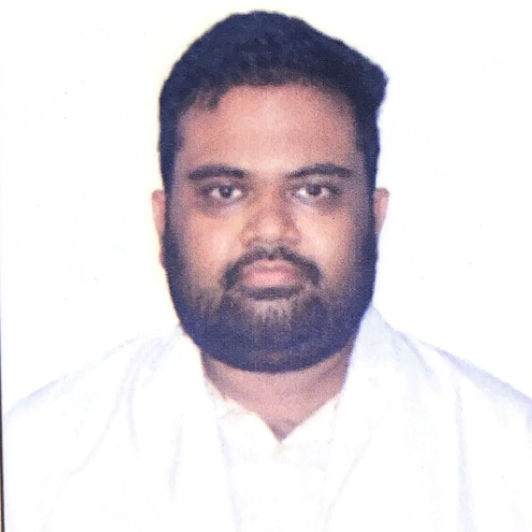Linga Mudra Steps, Benefits, and Precautions
Learn Linga Mudra steps, potential benefits, and safety tips. Get beginner-friendly guidance on this yoga mudra and how to use it for relaxation and focus.

Written by Dr. J T Hema Pratima
Reviewed by Dr. D Bhanu Prakash MBBS, AFIH, Advanced certificate in critical care medicine, Fellowship in critical care medicine
Last updated on 15th Nov, 2025

Introduction: Why Linga Mudra Matters
If you have ever wondered how a small, mindful habit could help you feel calmer and more centred, yoga mudras are worth exploring. Among them, Linga Mudra stands out because of its simplicity and grounding effect. A mudra is a symbolic hand gesture used in yoga and meditation to promote focus and awareness. Linga Mudra involves interlacing the fingers with one thumb pointing upwards. While scientific research on mudras is limited, many people find that pairing hand gestures with slow breathing creates a moment of stillness, balance, and inner calm.
Modern life encourages constant stimulation—screens, deadlines, and multitasking—which can leave the mind scattered. Practising a mudra like Linga Mudra offers a practical pause. When people report feeling more relaxed or focused, it is likely due to the combination of stillness, mindful breathing, and withdrawing from external distractions. This article explains how to perform Linga Mudra step by step, the potential benefits and realistic expectations, and how to use it safely and meaningfully within your daily routine.Consult a Top General Practitioner for Personalised Advice
What Is Linga Mudra?
Linga Mudra is a traditional yoga gesture where the fingers of both hands interlace and one thumb points upward. The word linga refers to a symbolic representation of energy or inner heat. In yoga teaching, the upward-facing thumb can signify rising awareness, vitality, or engagement of internal focus.
Although mudras are often part of spiritual or meditative practices, you do not need any prior experience in yoga to try Linga Mudra. It requires no equipment, no particular fitness level, and can be performed almost anywhere—during a commute break, before meditation, or while unwinding at home.
It is important to keep expectations grounded. Mudras alone are not scientifically proven treatments for illnesses or chronic conditions. Instead, Linga Mudra acts as a tool that supports mindfulness, which is well-recognised for its benefits on emotional regulation, stress reduction and increased mental clarity.
How to Perform Linga Mudra (Step-by-Step Guide)
The step-by-step guide includes:
1. Find a Comfortable Body Position
• Sit upright on a chair or cushion, allowing the spine to lengthen naturally.
• Relax the shoulders and soften the jaw and facial muscles.
• You may also practise while standing if that feels more natural.
2. Hand Position
• Bring both hands in front of your chest or abdomen.
• Interlace your fingers, ensuring your palms face each other.
• Allow one thumb to point straight upward.
• Gently wrap the other thumb around its base, or rest it along the side comfortably.
3. Maintain Gentle Pressure
• Hold the gesture lightly—avoid gripping or squeezing tightly.
• Keep your wrists in a neutral position rather than bending them sharply.
4. Focus on Your Breathing
• Breathe in and out through the nose, keeping the breath relaxed.
• Try breathing in for a slow count of four and exhaling for four, without forcing the rhythm.
• Relax the shoulders and neck as you breathe.
5. Duration and Frequency
• Begin with 3–5 minutes once per day.
• If comfortable, slowly increase to 10–15 minutes, once or twice a day.
• Stop sooner if there is discomfort, tingling or numbness in the hands.
Potential Linga Mudra Benefits (With Realistic Perspective)
Linga Mudra is commonly used for mindfulness, grounding, and focus. While clinical studies specific to Linga Mudra are limited, its benefits may arise from breathing, stillness and focused attention. The benefits are:
Focus and Mindfulness
• Helps direct attention, reducing distraction and mental clutter.
• The posture acts as a physical cue, reminding you to stay present.
• Supports developing a habitual moment of calm, even during stressful days.
Evidence context: Although studies on mudras themselves are limited, mindfulness and breathing are widely supported by research in stress reduction and emotional management.
Relaxation and Stress Relief
• Encourages slow breathing, which may calm the nervous system.
• Creates a pause in the day where you intentionally slow down and reset.
• Supports feelings of mental clarity after periods of stress.
Evidence context: Mudras may be the anchor, but the calming effect likely comes from stillness and breath focus.
Warmth and Circulation (Traditional Perspective)
• Traditionally associated with warmth and increased inner energy.
• Some people report their hands feeling warmer during practice.
Evidence context: Warming sensations may be linked to muscle engagement and heightened awareness, rather than a proven physiological effect.
Posture Awareness and Habit-Building
• Encourages sitting upright and breathing deeply.
• Helps in building a consistent relaxation habit.
• Offers a structured way to incorporate mindfulness into daily routines.
Precautions and Safety Tips
Linga Mudra is gentle, but mindfulness includes listening to your body. Precautions and safety tips include:
• Do not grip tightly; keep hand tension soft.
• If you have arthritis, carpal tunnel syndrome, or a recent wrist/hand injury, reduce practice time and prioritise comfort.
• Avoid long breath-holding, especially if you have high blood pressure or cardiovascular conditions.
• Stop immediately if you feel dizziness, numbness or overheating.
• Do not use mudras as a substitute for medical care.
When and How Long to Practise?
It can be done as:
• Best times include early morning, during a midday break, or before sleep.
• Start with 3–5 minutes, increasing to 10–15 minutes if comfortable.
• Consistency is more impactful than duration.
Combining Linga Mudra With Breath and Mindfulness
To deepen the practice, pair the mudra with gentle mindfulness techniques:
• Even-count breathing (inhale for four counts, exhale for four).
• Body scan—release tension from the face, jaw, shoulders and back.
• Intention setting—repeat a quiet phrase such as “relax and soften”.
Who Might Benefit From Practising It?
It may benefit in following scenarios:
• Individuals new to meditation need a simple focus tool.
• Students seeking improved concentration.
• Professionals who want mindful breaks between tasks.
• Anyone wishing to build calming habits for stress management.
Common Mistakes to Avoid
Common mistakes to avoid are:
• Gripping hands too tightly.
• Forcing the breath, making you feel strained.
• Hunching shoulders or tightening the neck.
• Practising too long initially, leading to hand fatigue.
• Expecting the mudra to solve medical problems.
How Linga Mudra Fits Into a Healthy Routine?
Think of Linga Mudra as one piece in a broader self-care process. Good sleep, movement, hydration and balanced nutrition matter more for health than any single meditation tool. Mudras help by improving the quality of the moment rather than replacing medical or lifestyle strategies.
Linga Mudra encourages pausing, creating a gentle mental reset, and carving out intentional stillness. Over time, those few minutes of mindfulness can become a reliable anchor in your daily routine.
Conclusion
Linga Mudra is a simple and approachable mindfulness practice that encourages stillness, focus, and relaxation. While clinical research on mudras is limited, many people find value in the grounding blend of hand positioning, slow breathing and pausing from distractions. Practised regularly and gently, it offers a moment of calm that can reset your mood and help manage stress. Consider it a supportive ritual—not a cure—and combine it with healthy lifestyle habits for long-term wellbeing.Consult a Top General Practitioner for Personalised Advice
Consult a Top General Practitioner for Personalised Advice

Dr. Abhirup Chakrabarti
General Practitioner
10 Years • MBBS
Chennai
Dr Abhirup Chakrabarti, Chennai
Dr. Pradeep Kumar Upadhyay
General Practitioner
23 Years • MBBS, PGD(Geriatrics)
Vadodara
Divyaa Clinic, Vadodara

Dr. Riti Srivastava
General Practitioner
12 Years • MD (Physician)
Gautam Buddha Nagar
Shri Krishna Clinic, Gautam Buddha Nagar

Dr. Avinash Pasuparthy
General Practitioner
5 Years • MBBS
Visakhapatnam
Apollo Clinic Vizag, Visakhapatnam

Dr. Ritesh Motghare
General Practitioner
18 Years • MBBS PGCDM
Nagpur
HEALTH CENTRE VNIT NAGPUR, Nagpur
Consult a Top General Practitioner for Personalised Advice

Dr. Abhirup Chakrabarti
General Practitioner
10 Years • MBBS
Chennai
Dr Abhirup Chakrabarti, Chennai
Dr. Pradeep Kumar Upadhyay
General Practitioner
23 Years • MBBS, PGD(Geriatrics)
Vadodara
Divyaa Clinic, Vadodara

Dr. Riti Srivastava
General Practitioner
12 Years • MD (Physician)
Gautam Buddha Nagar
Shri Krishna Clinic, Gautam Buddha Nagar

Dr. Avinash Pasuparthy
General Practitioner
5 Years • MBBS
Visakhapatnam
Apollo Clinic Vizag, Visakhapatnam

Dr. Ritesh Motghare
General Practitioner
18 Years • MBBS PGCDM
Nagpur
HEALTH CENTRE VNIT NAGPUR, Nagpur
More articles from General Medical Consultation
Frequently Asked Questions
Q.What is Linga Mudra used for?
It is used for:
• Traditionally linked to focus, warmth and energy.
• In modern use, people practise it mainly to support mindfulness and relaxation.
• It should be viewed as a tool for awareness and breathing—not as a treatment.
Q.How long should I hold Linga Mudra?
.Follow the tips below:
• Begin with 3–5 minutes.
• Gradually increase to 10–15 minutes if it remains comfortable.
• Frequency and consistency are more important than duration.
Q.Can Linga Mudra cure colds or sinus issues?
No. Mudras are not treatments for infections or medical conditions.They may help you relax, but should not replace medical care.
Q.Is Linga Mudra safe every day?
Yes, for most people, when practised gently. Avoid tight gripping, strain or forceful breathing.
Q.How is Linga Mudra different from other mudras?
It differs by:
• Each mudra has a unique hand shape.
• Linga Mudra uses interlaced fingers with one thumb upright.
• It serves as a physical cue to focus on stillness and breath.




